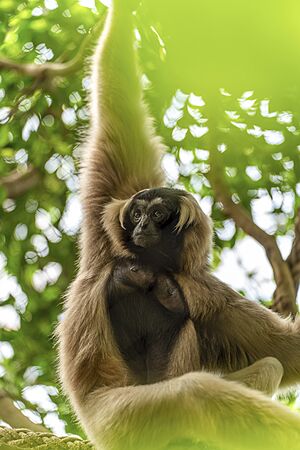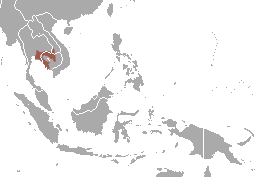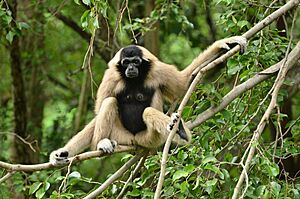Pileated gibbon facts for kids
Quick facts for kids Pileated gibbon |
|
|---|---|
 |
|
 |
|
| Male (dark) and female (pale) | |
| Conservation status | |
| Scientific classification | |
| Genus: |
Hylobates
|
| Species: |
pileatus
|
 |
|
| Pileated gibbon range | |
The pileated gibbon (Hylobates pileatus) is a type of primate. It belongs to the gibbon family, called Hylobatidae. These amazing animals are known for their long arms and how they swing through trees.
Pileated gibbons have different fur colors depending on if they are male or female. This is called sexual dimorphism. Males have completely black fur. Females have white-grey fur, but their belly and head are black. Both males and females have a white, often shaggy, ring of hair around their head.
Sadly, the pileated gibbon is an endangered animal. This means there are not many left in the wild. They are also listed in CITES Appendix I, which helps protect them from illegal trade. Their biggest problem is habitat destruction. The forests where they live are being turned into farms. This has made them disappear from some areas. Also, like many other primates, they are sometimes hunted. They are also captured and sold illegally as pets or for meat. Many groups are working hard to help these gibbons. They are trying to count them in the wild and help them in zoos.
Contents
Where Pileated Gibbons Live and What They Do
The pileated gibbon lives in eastern Thailand, western Cambodia, and southwest Laos. Their way of life is similar to other gibbons. They are active during the day and live in trees. This is called being arboreal.
They usually live in pairs, which means one male and one female stay together. They swing through the trees using their long arms. This special way of moving is called brachiation. Pileated gibbons mostly eat fruits and leaves. They also eat small animals sometimes. We don't know much about how they have babies. But it is thought to be like other gibbons. Mating pairs also mark their home area together. They do this by making loud calls to show other gibbons where their territory is.
You can find pileated gibbons in these places:
- Khao Yai National Park, Thailand
- Thap Lan National Park, Thailand
- Khao Ang Ru Nai Sanctuary, Thailand
- Khao Soi Dao Sanctuary, Thailand
- Pang Sida National Park, Thailand
- Ta Phraya National Park, Thailand
- Cardamom Mountains, Cambodia (about 20,000 gibbons live here)
- Bokor National Park, Cambodia (about 1,000 gibbons live here)
There are about 35,000 pileated gibbons in Cambodia. About 30,000 live in Thailand.
Helping Pileated Gibbons: Rescue and Release
A group called Wildlife Alliance works with the Cambodian government. They have programs to rescue and release pileated gibbons in Cambodia.
Rescue Efforts
There is a special team called the Wildlife Rapid Rescue Team. This team works to stop the illegal trade of wild animals in Cambodia. They have rescued many animals. Between 2001 and 2013, they saved over 56,000 live animals! Most of these animals are set free right away in safe places. If an animal needs help, it goes to the Phnom Tamao Wildlife Rescue Centre. Gibbons are in danger from being caught for meat or to be sold as pets. They also lose their homes when forests are cut down.
Rehabilitation and Care
Most pileated gibbons at the Phnom Tamao Wildlife Rescue Centre were saved from illegal trade. They might be too used to humans to go back to the wild right away. But the center has a special program. Mother gibbons raise their own babies there. This helps the young gibbons learn how to live in the wild.
Returning to the Wild
In December 2013, a pair of pileated gibbons were successfully released. They were set free in the protected forests of the Angkor UNESCO World Heritage Site. This area is near the famous ancient temples. This project was a team effort by Wildlife Alliance, the Cambodian Forestry Administration, and the Apsara Authority. It is the first step in helping these forests have more gibbons again.



